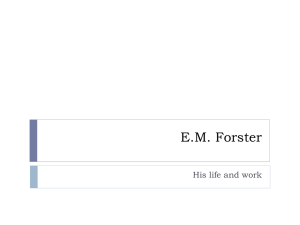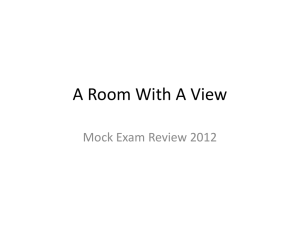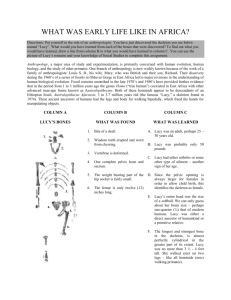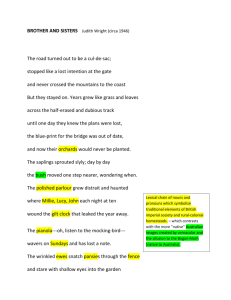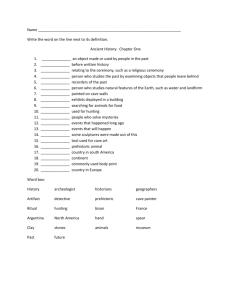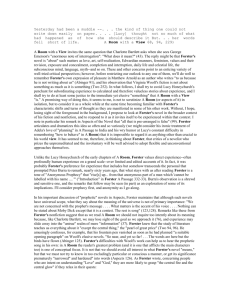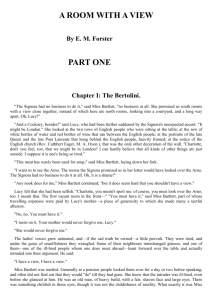Basilica of Santa Croce, Florence
advertisement
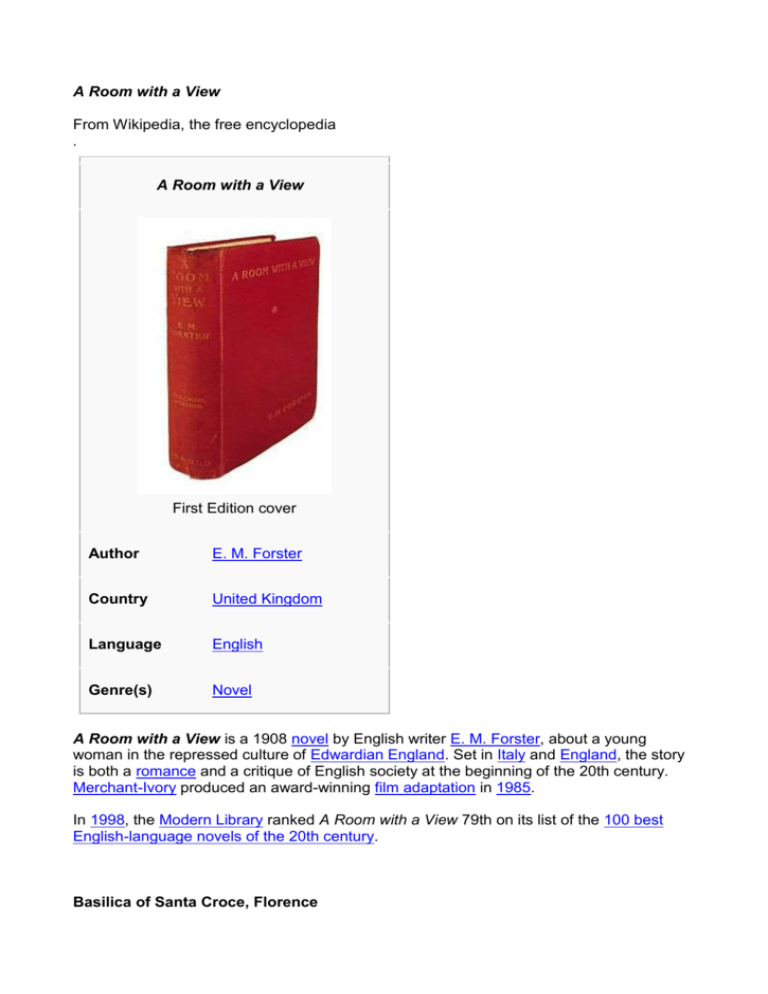
A Room with a View From Wikipedia, the free encyclopedia . A Room with a View First Edition cover Author E. M. Forster Country United Kingdom Language English Genre(s) Novel A Room with a View is a 1908 novel by English writer E. M. Forster, about a young woman in the repressed culture of Edwardian England. Set in Italy and England, the story is both a romance and a critique of English society at the beginning of the 20th century. Merchant-Ivory produced an award-winning film adaptation in 1985. In 1998, the Modern Library ranked A Room with a View 79th on its list of the 100 best English-language novels of the 20th century. Basilica of Santa Croce, Florence From Wikipedia, the free encyclopedia Basilica of Santa Croce in Florence The Basilica di Santa Croce (Basilica of the Holy Cross) is the principal Franciscan church in Florence, Italy, and a minor basilica of the Roman Catholic Church. It is situated on the Piazza di Santa Croce, about 800 metres south east of the Duomo. The site, when first chosen, was in marshland outside the city walls. It is the burial place of some of the most illustrious Italians, such as Michelangelo, Galileo, Machiavelli, Foscolo, Gentile and Rossini, thus it is known also as the Temple of the Italian Glories (Tempio dell'Itale Glorie). Interior towards the main entrance The Basilica is the largest Franciscan church in the world. Its most notable features are its sixteen chapels, many of them decorated with frescoes by Giotto and his pupils, and its tombs and cenotaphs. Legend says that Santa Croce was founded by St Francis himself. The construction of the current church, to replace an older building, was begun on 12 May 1294,[1] possibly by Arnolfo di Cambio, and paid for by some of the city's wealthiest families. It was consecrated in 1442 by Pope Eugene IV. The building's design reflects the austere approach of the Franciscans. The floorplan is an Egyptian or Tau cross (a symbol of St Francis), 115 metres in length with a nave and two aisles separated by lines of octagonal columns. To the south of the church was a convent, some of whose buildings remain. In the Primo Chiostro, the main cloister, there is the Cappella dei Pazzi, built as the chapter house, completed in the 1470s. Filippo Brunelleschi (who had designed and executed the dome of the Duomo) was involved in its design which has remained rigorously simple and unadorned. In 1560, the choir screen was removed as part of changes arising from the CounterReformation and the interior rebuilt by Giorgio Vasari. As a result, there was damage to the church's decoration and most of the altars previously located on the screen were lost. The campanile was built in 1842, replacing an earlier one damaged by lightning. The neoGothic marble façade, by Nicolò Matas, dates from 1857-1863. A Jewish architect Niccolo Matas from Ancona, designed the church's 19th century neoGothic facade, working a prominent Star of David into the composition. Matas had wanted to be buried with his peers but because he was Jewish, he was buried under the porch and not within the walls. In 1866, the complex became public property, as a part of government suppression of most religious houses, following the wars that gained Italian independence and unity. [2] [3] The Museo dell'Opera di Santa Croce is housed mainly in the refectory, also off the cloister. A monument to Florence Nightingale stands in the cloister, in the city in which she was born and after which she was named. Brunelleschi also built the inner cloister, completed in 1453. In 1966, the Arno River flooded much of Florence, including Santa Croce. The water entered the church bringing mud, pollution and heating oil. The damage to buildings and art treasures was severe, taking several decades to repair. Today the former dormitory of the Franciscan Friars houses the Scuola del Cuoio (Leather School)[1]. Visitors can watch as artisans craft purses, wallets, and other leather goods which are sold in the adjacent shop. It is briefly featured in the video game Assassin's Creed II, as Ezio Auditore da Firenze makes his first prominent kill in its courtyard during an exhibition of Verrochio's artwork. Major themes The main themes of this novel include repressed sexuality, freedom from institutional religion, growing up and true love. It is written in the third person omniscient, though particular passages are often seen "through the eyes" of a specific character. A Room with a View is Forster's most romantic and optimistic book. He utilizes many of his trademark techniques, including contrasts between "dynamic" and "static" characters. "Dynamic" characters are those whose ideas and inner-self develop or change in the plot, whereas "static" characters remain constant. Published in 1908, the novel touches upon many issues surrounding society and politics in early 20th century Edwardian culture. Forster differentiates between conservative and radical thinking, illustrated in part by his contrasts between Medieval (Mr. Beebe, Miss Bartlett, Cecil Vyse) and Renaissance characters (Lucy, the Emersons). Lucy personifies the young and impressionable generation emerging during that era, during which women's suffrage would gain strong ground. Forster, manifesting his own hopes for society, ends the book with Lucy having chosen her own path — a free life with the man she loves. The novel could even be called a Bildungsroman, as it follows the development of the protagonist. Binary opposites are played throughout the novel, and often there are mentions of "rooms" and "views". Characters and places associated with "rooms" are, more often than not, conservative and uncreative — Mrs Honeychurch is often pictured in a room, as is Cecil. Characters like Freddy and the Emersons, on the other hand, are often described as being "outside" — representing their open, forward-thinking and modern character types. There is also a constant theme of Light and Dark, where on many occasions, Cecil himself states how Lucy represents light, but Forster responds but stating how Cecil is the Dark, alluding to the fact that they can never be together, and that she really belongs with George. Interestingly, the name Lucy means "light", while the name Cecil means "blind", i.e. one who is "in the dark". Forster also contrasts the symbolic differences between Italy and England. He idealized Italy as a place of freedom and sexual expression. Italy promised raw, natural passion that inspired many Britons at the time who wished to escape the constrictions of English society. While Lucy is in Italy her views of the world change dramatically, and scenes such as the murder in the piazza open her eyes to a world beyond her "protected life in Windy Corner". Plot Room with a View, A , a novel by E. M. *Forster published 1908. It opens in an English pensione in Florence with a confrontation between Lucy Honeychurch's chaperone Miss Bartlett and the upstart Mr Emerson and his son George; the two men generously, but in Miss Bartlett's view indecorously, offer to exchange rooms, in order to give the ladies the benefit of a room with a view, a favour which they reluctantly accept. The novel describes the inmates of the Pensione Bertolini, among them the clergyman Mr Beebe and the 'original' lady novelist Miss Lavish, and their reactions to Italy and to one another. Lucy, an impressionable and artistic but immature girl, is disturbed first by witnessing a street murder, and then by an impulsive embrace from George Emerson during an excursion to Fiesole. Miss Bartlett removes her charge from these dangers, and the two return to Summer Street, in Surrey, where Lucy becomes engaged to a cultured dilettante, Cecil Vyse, whom Mr Beebe, who has reappeared as the local vicar, ominously describes as 'an ideal bachelor'. The Bertolini cast continues to reassemble as the Emersons take a villa in the neighbourhood. Lucy comes to realize that she loves George, not Cecil, hut it takes her some time to extricate herseif (helped, unexpectedly, by Miss Bartlett) from what she describes as 'the muddle'. The second half of the drama is played against a sharply and intimately observed background of tennis and tea parties and amateur piano recitals; it ends in the Pensione Bertolini, with George and Lucy on their honeymoon. As in *Where Angels Fear to Tread , Forster satirizes the English abroad, criticizes the sterility, snobbery, and 'witty weariness' of the self-consciously cultured, and describes Italy itself as a liberating vision. Summer Street, however, is seen with much more affection than Sawston, and the easy-going Mrs Honeychurch (based on Forster's maternal grandmother) and Lucy's brother Freddy are portrayed with sympathy. The moments of abandon - George's embrace in a field of violets, the naked bathing party in a pool in the Surrey woods (ch. 12) - are handled with a light touch that does not disturb the comedy of manners. (Text from Drabble, Margaret. The Oxford Companion to English Literature. Oxford, New York: OUP, 1998.; © Margaret Drabble and Oxford University Press 1985, 1995; cited here by permission of Oxford University Press.) Film Adaption A Room with a View (1986) was directed by James Ivory, adaption for film by Ruth Prawer Jhabvala. "How the book and film compare: The film is remarkably faithful to its source material, with whole scenes lifted almost verbatim from the page. Many of the chapter headings are retained, used as Brecht-style structural devices. The film does, however, dilute Forster's political concerns; all mention of Emerson's socialism is removed. Inspirations and influences: A Room With a View proved a landmark in the rise of the British costume movie. Films like The Go-Between (1971), Tess (1979) and The French Lieutenant's Woman (1981) concentrated on serious-minded sexual subtexts; the deftness of Merchant Ivory's comic touch meant A Room With a View operated almost independently of historical context, and more like a mainstream romantic comedy. It paved the way for a revived interest in other comic narratives, principally the Jane Austen revival of the 1990s, with Sense and Sensibility (1995) and Emma (1996)" (Pulver). Cast overview, first billed only: Maggie Smith - Charlotte Bartlett, Helena Bonham Carter Lucy Honeychurch, Denholm Elliott - Mr. Emerson, Julian Sands - George Emerson, Simon Callow - The Reverend Mr. Beebe, Patrick Godfrey (I) - The Reverend Mr. Eager, Judi Dench - Miss Lavish, Fabia Drake - Miss Catharine Alan, Joan Henley - Teresa Alan, Amanda Walker (I) - The Cockney Signora, Daniel Day-Lewis - Cecil Vyse, Maria Britneva - Mrs. Vyse, Rosemary Leach - Mrs. Honeychurch, Rupert Graves - Freddy Honeychurch, Peter Cellier - Sir Harry Otway, ....; runtime: 117 min. IF YOU WANT TO REVISE SOME OF THE SCENES FROM THE FILM WE SAW AT SCHOOL YOU CAN USE www.youtube.com AND TYPE ‘A ROOM WITH A VIEW’. FIND THREE ADJECTIVES TO DESCRIBE ENGLAND AND ITALY AS E.M.FORSTER PRESENTS THEM IN HIS 1908 NOVEL ‘A ROOM WITH A VIEW’. DO YOU AGREE?BRIEFLY EXPLAIN. (60/80 words)
